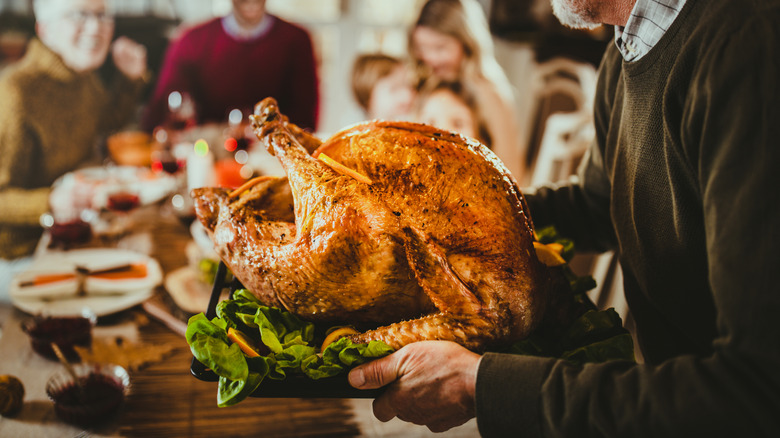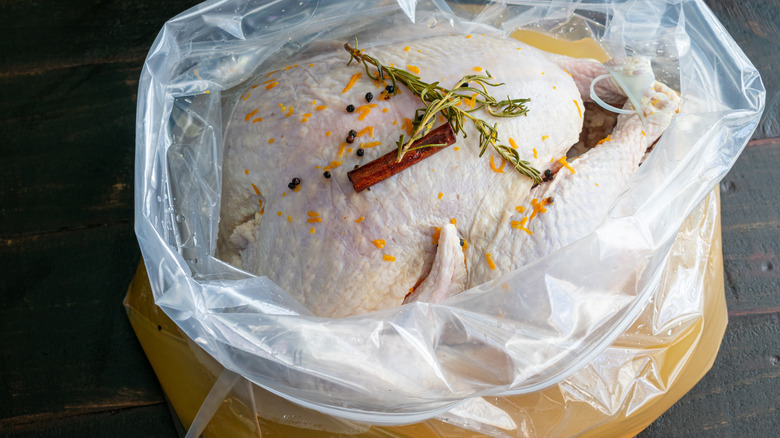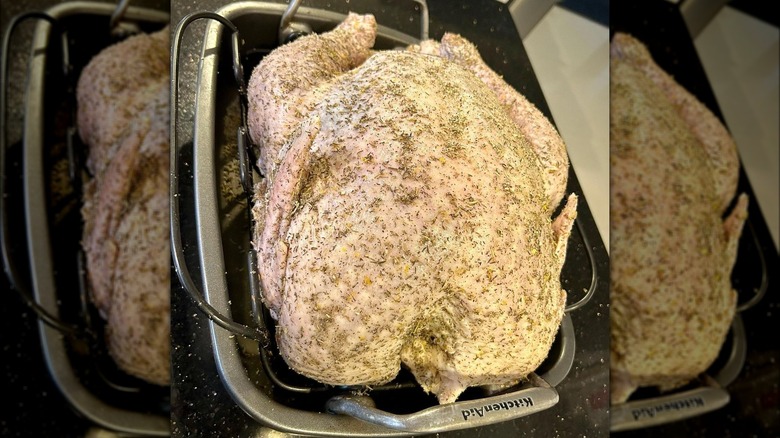When It Comes To Your Thanksgiving Turkey, The Brine You Use Matters
Thanksgiving is almost here, and for the amateur and pro cook alike, there's a lot of research that goes into planning the perfect meal. Like, did you know yams and sweet potatoes aren't the same thing? Or how a simple butter trick can make pie crusts flaky? And that's just the sides and dessert. Planning for the main event — the turkey — is the most important task of all, lest you want a relative to bring up your dry bird at every family get-together for the rest of your life.
Thankfully, there is one cooking trick that's sort of like turkey insurance: using a brine. Brines use salt to improve the texture, moisture content, and flavor of meat, and they're a surefire way to keep your turkey moist this year. But not all brines are created equal; if you're in charge of the turkey this year and are thinking of brining your bird, there's probably one big question on your mind: should you use a wet brine or a dry brine? Both methods have pros and cons, but it turns out most experts these days recommend a dry brine.
The problems with wet brines
Wet brines infuse turkey with moisture and flavor through the process of osmosis and capillary action, according to Science of Cooking. The turkey is submerged in salted water, hydrating the cells of the muscle fibers so they hold more moisture, which results in a juicier turkey as it cooks. It also makes the meat more tender, due to the fact that the salt solution makes it harder for the muscle filaments in the meat to contract when they're cooked. But wet brining has a few big problems in a home kitchen.
Fitting a large Thanksgiving turkey in the fridge so it can thaw is already a big hassle for many home cooks who have a standard-sized refrigerator. Now imagine placing that turkey into a bag or container full of liquid, and putting that into the fridge. Wet brining requires a lot of fridge space. Well, fridge space or a large cooler big enough to fit a turkey that you can somehow make sure stays at a food-safe temperature while the turkey brines. For a lot of people, neither of these options is very feasible, but that's what wet brining requires. On top of these space constraints, wet brining can also result in a bird that, while juicy, is flavorless, and if you don't dry the turkey off really well before cooking, you can wind up with pale, limp skin. That's why many people prefer dry brining.
Fo for a dry brine for better results
There are a few reasons why dry brining is the preferred choice of many cooks, the first of which is that it's pretty easy. Most people season their turkey before roasting it anyway; with a dry brine, you just use extra salt and let the turkey sit in the dry brine for a few hours or even a few days before cooking. The second reason is that food science shows that it's also effective at tenderizing turkey and keeping it juicy.
Rubbing your turkey meat in salt first draws juices out of the turkey via osmosis. Those juices dissolve the salt on the surface of the turkey, creating a salty brine, which then starts breaking down and relaxing the muscle fibers of the meat. This in turn allows the meat to reabsorb the now-salty juices. The end result is seasoned, tender, and juicy turkey meat, with exceptionally crispy skin your family will fight over. And, while it still takes up space (your turkey will need to be uncovered in the fridge at least overnight), you won't have to deal with the hassle of putting gallons of poultry bacteria-contaminated brining liquid in the fridge. The next time you brine a turkey, consider doing a dry brine for best results and peace of mind.


